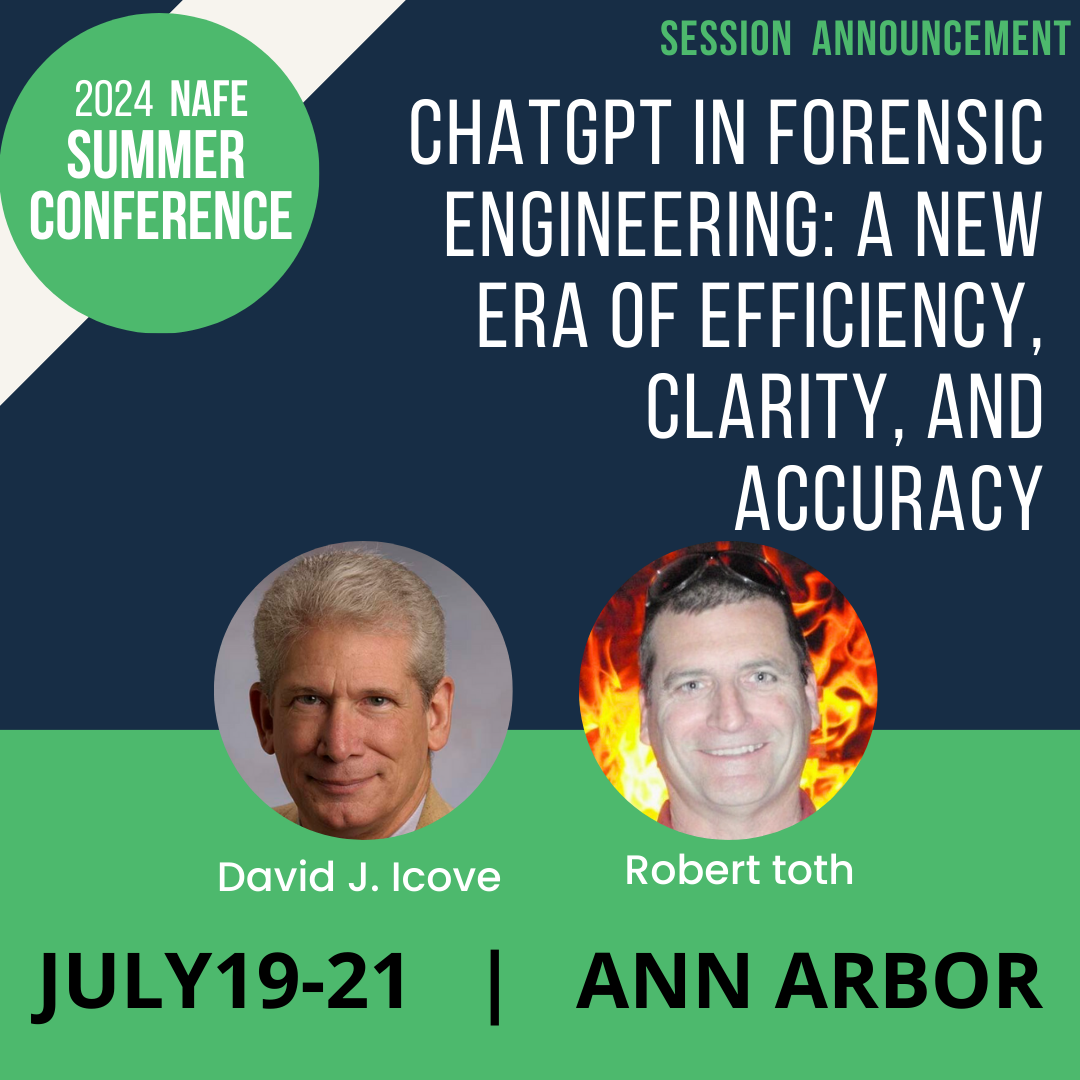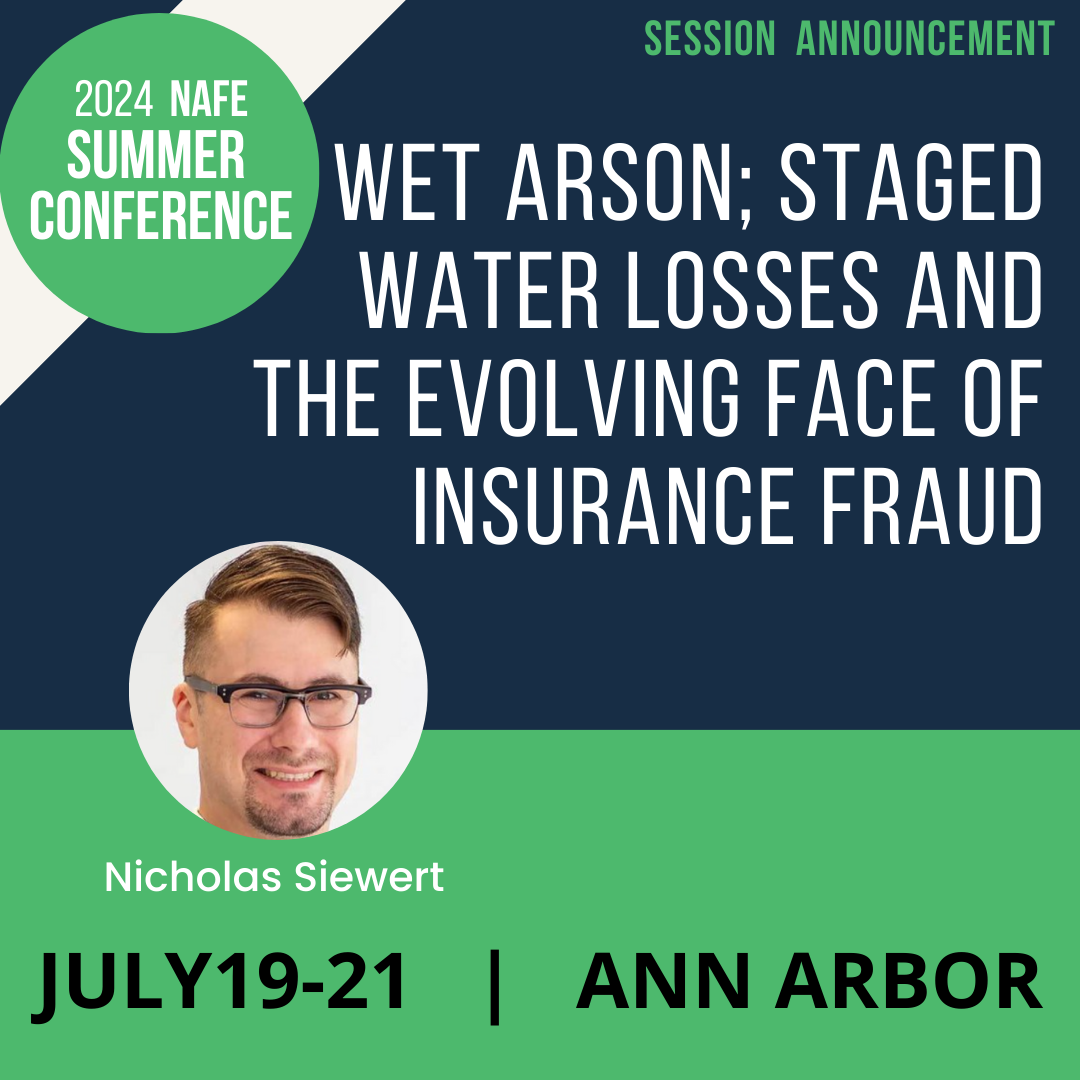
The 2024 Summer Conference of the National Academy of Forensic Engineers in Ann Arbor will begin Friday, July 19 at 8:30 a.m. local/Eastern time with the NAFE Board meeting, which is open to all current members in good standing. The conference proceedings will end at 5 pm on Sunday, July 21, 2024.
- Saturday Sessions -
8:00 AM - Forensic Engineering Analysis of Roadway Geometry and Traffic Control
Tim McClure, PE, PhD, Joshua Golomb, PE, & Jerry Ogden, PhD, PE (NAFE #561F)
When evaluating evidence for causative factors contributing to a motor vehicle collision event, consideration of roadway geometric, or traffic control, contributions should be examined. Roadway geometry, clear zone, safety features, visibility obstructions, or traffic control devices and placement may influence driver behaviors. Are the roadways involved designed and signed properly? The geometric design and traffic control requirements for special circumstances, such as a highway construction zone, mixed-use paths, railway crossings, or low traffic volume, may also present the potential for roadway issues. An evaluation of these potential contributing factors can open a Pandora's box of opportunities for errors when an improper engineering analysis follows. This paper explores the topics that guide a proper engineering analysis of roadway geometry and traffic control as they relate to determining which design standards, policies, or guidelines apply as well as the proper application of the semantics in these documents. Additionally, this paper addresses recommendations contained in research concepts or reports versus requirements for designer, constructor, or DOT. The discussion includes examples from past cases addressing the topics presented, providing a systematic approach to evaluating permanent or temporary roadway geometric or traffic control design for factors contributing to a collision event.
9:00AM - Forty Years of Advances in Failure Analysis of Polymeric Composite Materials
Geoffrey Clarkson, PE (NAFE #1143A) & Daniel Couture, PEng (NAFE #951S)
Use of polymeric composite materials is increasing in prevalence for applications ranging from fixed infrastructure installations to industrial chemical processes to electricity generation in addition to aero-nautical applications. Engineers have been able to codify design principles and manufacturing practices to be accessible to practitioners with general engineering education. In almost all cases, when polymeric com- posites enter service, none of the design codes, approaches, or construction standards apply, and they can- not be used to determine Fitness For Service. When failures occur, approaches that are normally followed in investigation yield inconclusive results, which often creates a conclusion that: “There was an undetected manufacturing defect.” All polymeric composites are non-crystalline, non-linear viscoelastic materials, and their mechanical properties change continuously while in service. This paper will describe how damage occurs to these materials, how it can be detected, and a methodology to approach these failures.
10:15 AM - Forensic Deformation Analysis of Clevis Failure
Wade Lanning, PhD, & Michael Stichter, PhD, PE (NAFE#1162M)
Photographic evidence can be a sufficient basis for a forensic failure analysis, especially when characteristic features of the failure mode are readily observed in photographs: deformation, fracture, etc. In this case, the failed component – a farm clevis or round pin shackle – was part of equipment used to attempt to recover a vehicle mired in the mud at an above-ground mine site. The shackle failed, and the shackle pin became a projectile that penetrated the cab and injured the driver. The subject clevis was not available for physical inspection or testing. However, photographs of the subject clevis were available. Application of solid mechanics principles made it possible to determine the sequence of deformation steps that occurred during the failure. Additionally, comparing the deformation behavior documented in photographs of the subject clevis and to exemplars allowed a determination of the strength of the subject clevis. Thus, investigators were able to use photographs to determine whether the shackle failed below its working load limit (WLL) or if a citation issued by the Mine Safety and Health Administration for using the subject clevis over its WLL was merited.
11:15 AM - Improving the Effectiveness of Forensic Engineering Reports
Michael Stall, PE (NAFE #955M)
Forensic engineers must be able to clearly communicate their evaluations, understandings and findings in effective and compelling forensic engineering reports. The typical FE is technically competent but is not necessarily an effective or compelling writer. Effective use of photography in terms of content, scale, exposure, focus, and clarity is very important, and examples of effective and questionable photographic uses are provided. Compelling use of the written word is part technical writing and part convincing prose, which is a skill that can be learned. Document formatting and layout are important aspects of establishing a relationship with the reader, and examples of formatting mistakes and improvements are provided. This paper gives examples from FE reports that fail to be convincing or compelling and provides suggestions for improvement. An important aspect of this paper focuses on providing instructions on how to best utilize photography, captions, illustrations, and text in order to clearly and effectively tell a persuasive story that people will want to read and that will clearly communicate the opinions and conclusions of the forensic engineer.
1:15 PM - Forensic Analysis of an Elevated Pool Vault
Brian Eubanks, PE (NAFE #962S) & Garrett Ryan, PE (NAFE #1125M)
Distress observed in the plaster lining and gunite/shotcrete of a pool structure located within a podium slab on the third floor of an eight-story student housing building located in central Texas was determined to be causally related to the gunite/shotcrete mix that combined high alkali Portland cement with siliceous aggregates sufficient to generate alkali-silica reaction (ASR). Upon demolition of the pool structure, design deficiencies were subsequently identified in the recessed concrete vault that supported the pool structure, including inaccurate structural design and analysis with finite element modeling software, inconsistencies in the thickness of the floor slab, omission of a shear key at the abutment/connection of the floor slab and the vault walls, and an inadequate amount of bonded, non-prestressed reinforcement in the floor slab, which culminated in the demolition and reconstruction of the vault. This paper will explore the different parties involved in the design and construction of the project, the errors that resulted in deficient conditions, and the positions maintained by the different forensic engineering consultants representing the various parties.
2:15 PM - Investigating the Effects of Imperfections on an Aluminum Stepladder Using Finite Element Analysis
John Thomazin, PE (NAFE #1188M), Bill Webster, & Sai Kosaraju
Ladders, while a useful tool, can also be alarmingly dangerous. According to the National Institute for Occupational Safety and Health (NIOSH), ladder-related falls cause a staggering number of more than 100 fatalities and thousands of injuries each year. The installation, maintenance, and repair industries bear the brunt of these ladder-related injuries. Ladders have made significant advancements in safety over the years, and the ANSI A14.2 standard governs the safe construction, design, testing, and use of portable metal ladders. The standard outlines construction requirements for ladder rung spacing, connections, and angle of inclination. About 15 different load tests are performed to ensure a ladder meets the standard. However, it's crucial to note that these tests were developed using statistical tolerances and represent pass/fail criteria to determine a ladder’s conformance to the standard. Altering the cross-section of a shape can increase or decrease its stiffness, and imperfections in a structure can affect its collapse. Changing the structure's geometry or cross-sectional area of a member can be an effective means of preventing buckling and fall-related injuries. It's important to know the testing limitations described in A14.2. 3D modeling and nonlinear finite element analysis can detect an imperfection-sensitive ladder and reduce ladder-related injuries and fatalities.
3:30 PM - Analysis of a UTV Axle Fracture
Stephen Batzer, PhD, PE (NAFE #677F)
The analysis of the fracture mechanism of a rear axle shaft of an off-road side-by-side utility vehicle (UTV) is presented. Two minors were recreating; they were riding the UTV within the fenced confines of the family farm. While on a dirt trail at a substantial velocity, the UTV yawed hard to the left, just before the turn in the trail. The leading side passenger’s side tires dug into the soft soil and the UTV overturned for three quarters of a revolution. The belted driver was partially ejected during the overturn and fatally pinned underneath the vehicle’s tubular rollover protective structure. After the event, the vehicle could not be driven as the left rear axle was fractured nearest the inner race of the outboard constant velocity (CV) joint and the wheel hub and disc brake system were damaged. The investigation answered the question regarding, “Did the overturn cause the axle fracture, or, did the axle fracture cause a braking action and initiate the overturn?”
4:30 PM - ChatGPT in Forensic Engineering: A New Era of Efficiency, Clarity, and Accuracy
David J. Icove, PhD, PE (NAFE #899F) & Robert Toth
Generative artificial intelligence (GenAI) tools are entering the fire investigation field, promising more efficiency, better access to standards and guides, and reduced time spent on rote tasks. However, these tools have inherent accuracy, ethics, and privacy risks. GenAI refers to algorithms commonly programmed to search and retrieve text, images, and data. An example might include reviewing a draft expert report for inconsistencies in assumptions based on fact scenarios. GenAI can be used to query historical voluminous report files, loss histories, and published court cases for similar fact scenarios. The objective of this paper is to provide NASFM members and attendees with productive examples of GenAI while maintaining proper ethical guidelines: provide real-world examples querying peer-reviewed literature and court cases having similar fact scenarios; demonstrate the ability to query textual data for present-day and historical fire investigations for questions such as “What are the loss histories of nursing home fires” and “Who were all the witnesses in your investigation who smelled gasoline?”













